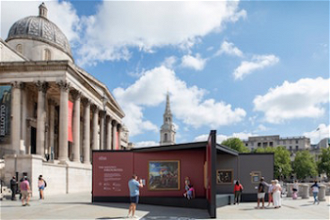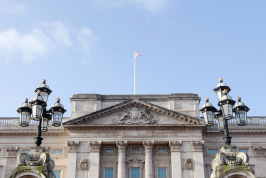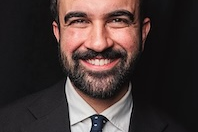Virtual Veronese at The National Gallery

Over the next few weeks visitors to the National Gallery can experience Veronese's The Consecration of St Nicholas using immersive technology to transport them to its original setting in the Abbey church of San Benedetto al Po, near Mantua. One of the largest Benedictine monasteries in sixteenth century Europe it was severely damaged in the 2012 earthquake.
Paoli Caliari, known as Veronese, was one of the most renowned Renaissance artists and ranked alongside Titian and Tintoretto. His grandiose, opulent style, mastery of colour, space and light inspired Rubens and heralded the Baroque style espoused by the Catholic Reformation. In 1561 he was commissioned by the monastery's Abbot Andrea Asola to paint the Consecration of St. Nicholas. The painting was completed in 1562 for a chapel on the right side of the nave.
Veronese depicts the saint's' consecration as bishop of Myra. An angel descends bearing a bishop's mitre, stole and crosier, indicating that Nicholas has been divinely chosen. Two witnesses wearing turbans point to the setting in Asia Minor, present day Turkey. The story of St Nicholas is included in cycles of paintings of his life, but this is the only known solo portrayal of the subject, illustrating the importance of vocation to the priesthood, and God's authority vested in a bishop. Dom Asola, as patron, is included as a cleric near the Archbishop.
Virtual Veronese provides an innovative 3D model of the chapel of St Nicholas built by Guilio Romano, pupil of Raphael. A volumetric video uses professional actors to relate its story. Helpful gallery assistants affix rather cumbersome apparatus to your head, following a short induction in health and safety. Rest assured everything is thoroughly sanitised. However, if you wear varifocals it is quite an issue to be able to view the scene in focus.
During the Napoleonic Wars the monastery was suppressed and Napoleon had the painting removed in 1797. Subsequently it was the first purchase made by the governors of the British Institution for Promoting the Fine Arts intending that it should adorn the future National Gallery.
Dr Rebecca Gill, former Ahmanson Curator in Art and Religion at the National Gallery, London, said: "Through this project we are able to bring architecture into the Gallery and allow our visitors to explore for themselves what it might have been like to stand in front of Veronese's painting some 500 years ago." She is one of two virtual guides giving different tours through the experience. Dr.Gill references the interesting frescoes of miracles associated with St Nicholas also featured in the chapel. One of these about the golden gifts to unmarried girls evolved into the tradition of Santa Claus.
The other tour takes us back in time with the monastery's Abbot, Dom Asola, and reveals the threat from the Inquisition facing them. Before the Reformation the monastery had explored scholarly notions, as had some of the Roman Cardinals, for reform within the Catholic Church. Only when the reformers rejected Church and Papal authority were these concepts considered unacceptable.
The monastery's renowned library included books written by Melanchthon and Luther which were subsequently regarded as heretical literature and the monks were investigated by the Inquisition. The eight minute video evokes a feeling of theatre in the round as we see the Abbot, ably portrayed by Welsh actor Grahame Fox, addressing a younger visiting monk, enthusiastically played by Simon Victor, about the situation. The monk has come to see Veronese's celebrated painting of St Nicholas, the 4th, century bishop who was a bastion of orthodoxy against the Arian heresy. A recording of Gregorian chant originally composed for the abbey, and sung by Veneti Cantores, is an effective conclusion.
The trouble is the inauthentic clerical garb is distracting to anyone familiar with Benedictine tradition. Benedictines are known as the Black Monks -but the monk wears a white habit. Whilst Cistercians wear white the monks in question are a part of the Subiaco Cassinese Congregation and very definitely wore black! Questioned about this the curatorial response is that black would have got lost in virtual reproduction. I disagree, white is less distinct against the white marble background. The Abbot is also portrayed wearing a very modern alb not compatible with 16th century Italian clerics. References to 'Senior' bishop in the text when referring to an Archbishop also grate as does Dr Gill's referral to power rather than authority being divested in bishops, and robe or garments as opposed to vestments.
These anachronisms dilute what is otherwise a fascinating outreach into modern technology. developed and produced by Focal Point VR.
Do view Veronese's actual painting in Room 9 afterwards.
7 March 2022 - (extended to) 6 April 2022
Gallery F, National Gallery
Admission free, ticketed
See: www.nationalgallery.org.uk
Not suitable for under 13's
















